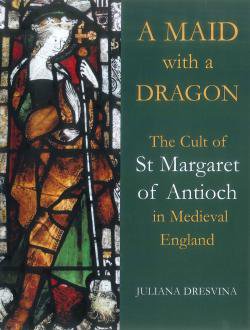How to train your dragon (and become a saint) - the medieval way
by Juliana Dresvina
20 Jun 2016
A special child raised in poverty and obscurity, courageous teenagers, dragons, ghostly apparitions, pretty strong-minded girls, corrupt men of power, dark dungeons, horrible injuries, miraculous recoveries, unjust deaths, triumphs against all odds – and all this written and rewritten dozens of times by enthusiastic audiences to make the story better fit their agenda. Enter fanfic of the medieval and post-medieval Christendom: hagiography.

Hagiography, or saints' lives (literally "saint-writing", from Greek hagios, holy / saint and graphia, writing), despite its pious name and relatively early-established canon, is an amazingly versatile genre, which served the purposes of both edification and entertainment. The best stories were told and retold in many languages and circulated in hundreds, if not thousands of versions. One of such immensely popular tales of hagiography was that of St Margaret (St Marina in the Greek tradition), who, like her folklore cousin Cinderella, was mistreated and rejected by her parents, went through impossible ordeals, aided by celestial creatures and her nurse / godmother, and was finally united with her beloved prince / Jesus Christ in the happily-ever-after / in the Kingdom of Heaven (because for a saint, the happy ending is his or her death – hence the day of their commemoration in the Catholic tradition is called dies natalis, Latin for birthday). Margaret's enemies numbered a lusty local governor with seemingly absolute authority, a host of his henchmen, a terrifying dragon, and his brother the black demon (second in Hell only to Beelzebub), which makes Cinderella's step-family pale into insignificance.
Of all the popular medieval saints, St Margaret is one of the most fascinating, but also the most problematic. The climax of her legend is the saint’s confrontation with the devil in the form of a dragon, when the devilish beast is said to have swallowed Margaret and then burst asunder, unable to contain such a holy creature in its stomach. This episode captured the imagination of the medieval west and was firmly established in iconography, making her one of the most frequently represented saints between the ninth and 16th centuries. This same story eventually led the Vatican to suppress her cult in 1969, alongside the cults of other saints with fairytale-like legends and no historical confirmation of their existence, such as St Christopher and St George. The origins of the cult of St Margaret are not clear: her martyrdom is generally thought to have taken place in the late third century, but apart from the legend there is no evidence concerning the saint in other contemporary sources. Her name suddenly starts to appear in liturgical manuscripts from the late eighth century onwards, probably a reflection of the translation of her relics to different places, including Italy and Constantinople, which took place around that time.
Versions of St Margaret’s life circulated in hundreds of manuscripts; she enjoyed a large number of church dedications (well over 200 in England alone); and she was depicted in thousands of images which were commissioned, owned, and venerated by members of all strata of medieval and modern society. It is only fitting then that such a character deserves a monograph of her own, which is what A Maid with A Dragon provides. By considering the different versions of St Margaret's legend, the iconographic evidence (stained glass, stone and wood carvings, paintings, manuscript illumination), the liturgy, preaching, and the other manifestations of the cult, and delineating the responses to the cult of different kinds and classes of people, the book explores the ways in which the story of St Margaret in England changed throughout the Middle Ages. At the same time, the popular saint acts as a lens through which to map the pious practices of these different groups of the population, as evident in patronage, readership, and pilgrimages – physical or literary. And of course Margaret's symbol and main enemy, the dragon, is given a place of honour: you can see how he changed through the centuries from a wolf- or serpent-like creature to something looking anything like a weasel, a cow, or a hedgehog!
Dr Juliana Dresvina is a tutor in Medieval and Renaissance Literature and Culture at Middlebury – CMRS Oxford Humanities Program, a research member of Wolfson College, Oxford, and a visiting scholar at St Edmund's College, Cambridge.


